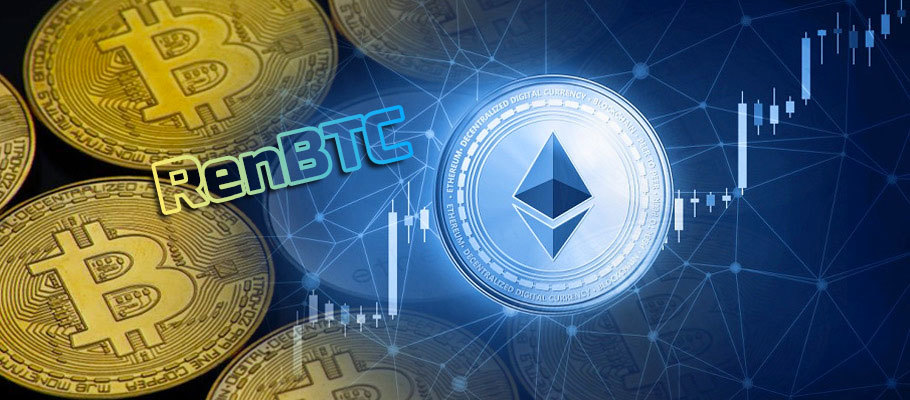
Published: May 25th, 2020
Ethereum was developed to modify the Nakamoto consensus. In the end, blockchains are supposed to be more efficient, have agreeably fast transaction speeds, and foster the flawless transfer of value. More research is still ongoing in this respect, and last week, the latest implementation of the BTC anchored on the Ethereum Blockchain went live.
There are 1.38096601 renBTC that are live on the Ethereum mainnet. This is according to Etherscan, the Ethereum platform’s sponsored tool that allows users to search as well as explore transactions on the Ethereum network. Sources privy to the project confirmed to the media that indeed it is the Ren smart contract that is already live on the Ethereum mainnet well ahead of the announcement of its launch.
On Wednesday, May 20, Kain Warwick, the CEO of the cryptocurrency-backed synthetic assets platform Synthetix announced that he had succeeded in holding a full Bitcoin in the new form, making him the first person to do so.
At the moment, members of the public cannot mint any more renBTC even though the smart contracts are already deployed on Ethereum. According to Taiyang Zhang, the chief executive of Ren, the company behind the project, mining renBTC is not possible as at now because Ren Virtual Machine (RenVM) is not yet on the Ethereum mainnet.
Taiyang explained that RenVM is a unique network that is separate from Ethereum, at least for now. Its mainnet subzero version will be deployed on Ethereum alright but only at a later time, Taiyang added.
Ren’s chief executive said that the renBTC that has been minted was done via the testing platform that Ren is working on as well as the testing system at Synthetix. This probably explains why Synthetix’s CEO already has renBTC even though the public is not yet able to mint the asset.
RenBTC is the latest of the many solutions that the blockchain technology space is building to expose assets backed by Bitcoin to the benefits that the various DeFi platforms on Ethereum offers.
According to a blog post on Medium written by Ren’s CTO Loong Wang, any asset that a user mints on the Ethereum network using RenVM is a 100% backed ERC-20. Essentially, this statement infers that if you mint 1 renBTC, then you can always exchange the same for 1 BTC. The representation is a direct supply measure; besides, the renBTC minted is neither synthetic nor does it rely on any liquidation mechanism. It is not even a representation of the value of Bitcoin on Ethereum.
Instead, it is a 1:1 representation of Bitcoin on the Ethereum network. Besides, the asset can be redeemed for Bitcoin in any amount and at any time.
The Ren Protocol helps users gain access to inter-blockchain liquidity by allowing them to mint BTC, BCH, and ZEC on the Ethereum mainnet. The contracts for these three tokens already exist in the Ren documentation.
Apart from the 1.38 renBTC that were minted during the trial, the repository also holds 3.32347417 renZEC, and negligible BCH (0.00000076 renBCH).
The Ren protocol was developed out of a crowdfunding effort that collected $30 million for the Republic Protocol. The core developers originally envisioned the project that would run venues that preserve privacy by keeping the order books secret, known among industry players as dark pools.
According to the information available on Crunchbase, the project got favorable backing from FBG Capital and Polychain Capital. Ren has, however, deviated from the original intention, choosing to, instead, provide inter-blockchain liquidity solutions.
Explaining his company’s move away from dark pools, Wang said that the decision was swayed by the architecture of the said pools. While talking to the Defiant, a daily online news publication that interrogates and makes sense of the confluence of finance and blockchain, Wang said that big trades exist on chains that are not compatible with Ethereum. And while ETH has massive liquidity, most big trades are BTC and USDT.
Working on dark pools, therefore, demands that solution providers leverage atomic swaps and other such technologies that allow individuals to exchange a cryptocurrency into another without employing centralized intermediaries.
Wang said that the approach available at the time was so painful. They had to look at the bigger picture and provide a solution for the interoperability problem first, he said. The executive concluded that their decision was informed by the fact that large liquidity can only be achieved when the interoperability conundrum has been solved.
Ren’s signature tool is the RenVM which offers a way for the protocol’s users to hold cryptocurrencies in multi-signature wallets that are controlled by nodes. These nodes are anchored in the tool’s skeleton. In that status, the protocol’s users can mint assets that are a representation of the existing assets and have the said assets in the form of ERC-20 tokens.
The minted tokens do have the same value as the assets they represent. However, they are for use on Ethereum. The Ethereum network has seen many tools such as the RenVM. Almost all, however, seek to provide interoperability of just one coin at a time. RenVM is different in that it is bringing not just BTC (renBTC) but also Bitcoin Cash (renBCH), and Zcash (renZEC) with more assets to follow soon.
Kain said in a post that upon completion of the project, a lot more BTC is going to end up in Ethereum. If the project succeeds in addressing the interoperability of the networks successfully, then it may significantly help Bitcoin address the age-long scalability challenge.
Interoperability remains a big challenge in the blockchain space. A lot of research is ongoing in this regard, and last week Ren went live on Ethereum in an attempt to bring BTC to Ethereum. The project allows users to mint asset representations of BTC on Ethereum. The Ren project, however, is different from other projects that work to create interoperability only one coin or asset at a time. The RenVM seeks to bring BTC, Bitcoin Cash, and Zcash to Ethereum.